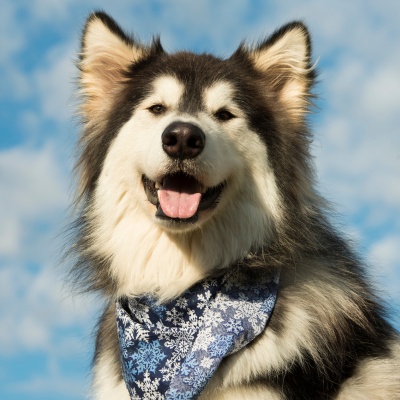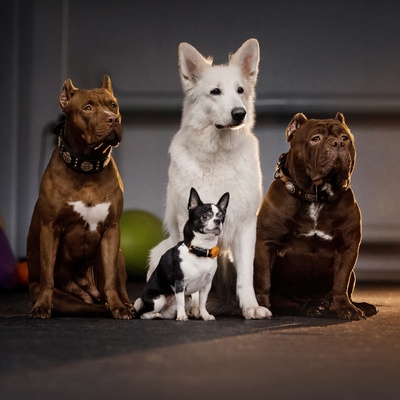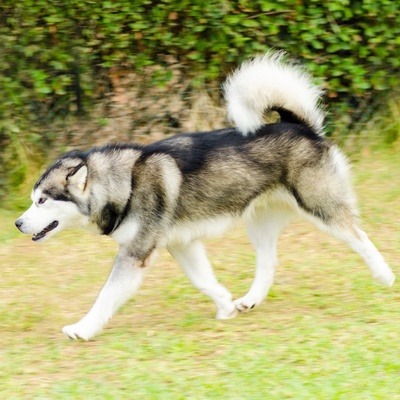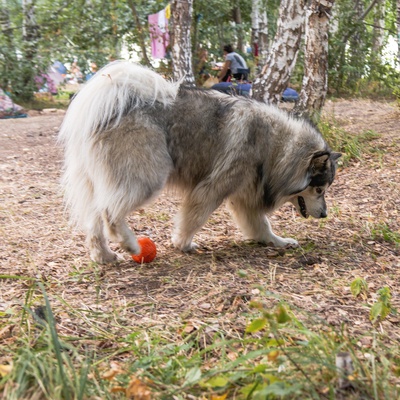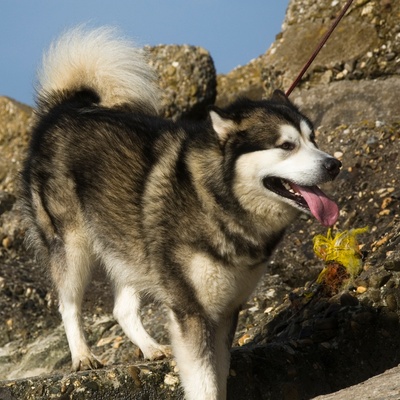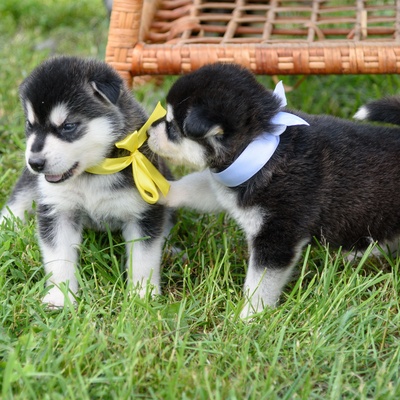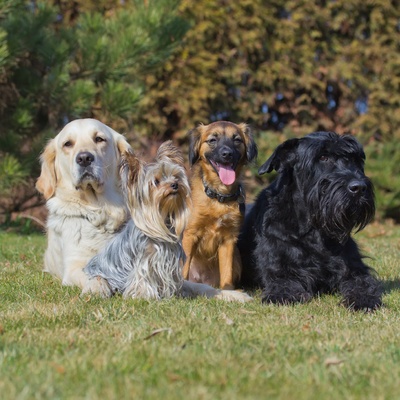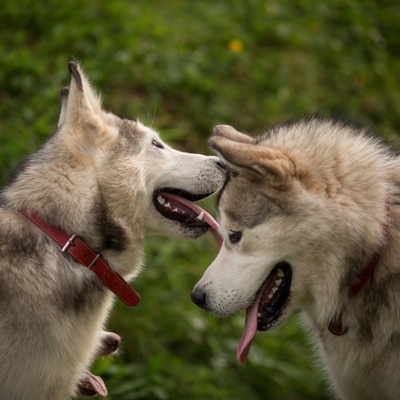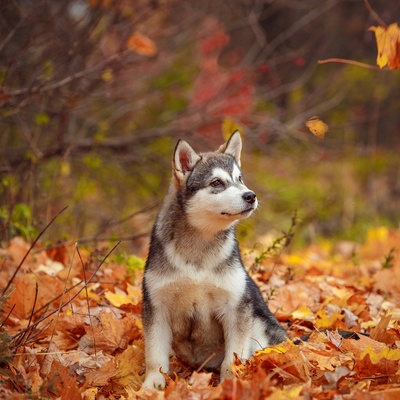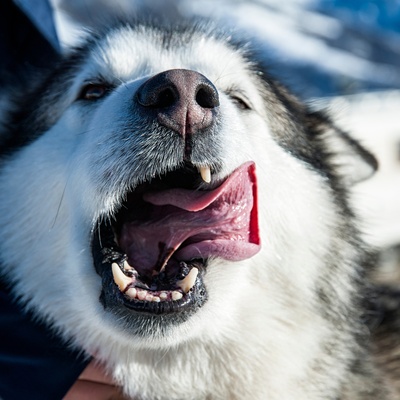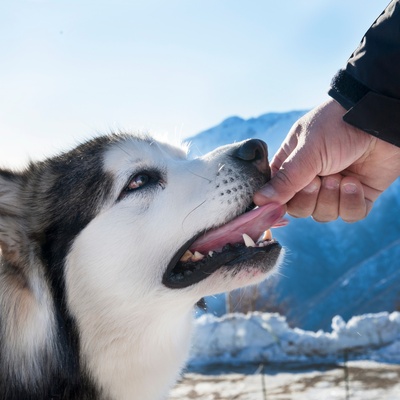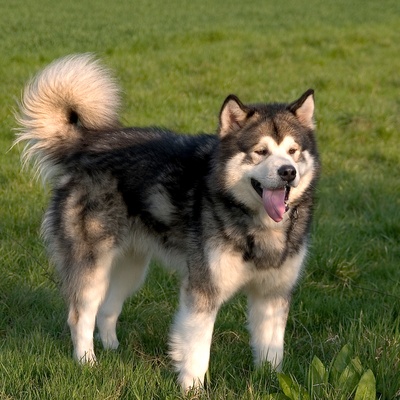Introducing the Alaskan Malamute
Discover all there is to know about the Alaskan Malamute : its characteristics, behavior, training, and its cost.
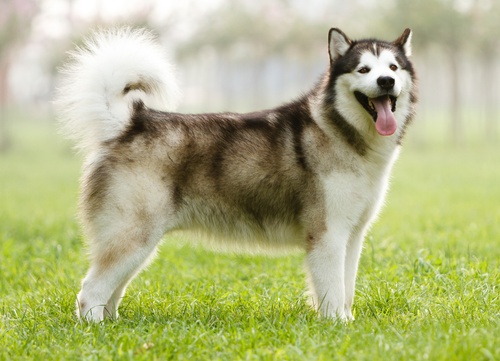
Discover all there is to know about the Alaskan Malamute : its characteristics, behavior, training, and its cost.
Originating from Alaska, the Alaskan Malamute is a breed of immense strength and endurance, initially bred for their prowess in hauling heavy freight as sled dogs. They stand as a testament to resilience and versatility in the harshest environments. Today, this breed is among the most cherished and admired worldwide, not just for its physical capabilities but for its exceptional temperament.
Whether it's for companionship, participating in dog sports, or lending their strength in activities like pulling sleds, they excel in multiple domains. They display their affection openly, making them excellent companions. Their sociability extends to both humans and other dogs, with a well-socialized Malamute often being the heart of any social gathering.
This section outlines the unique features of the Alaskan Malamute breed.
The Alaskan Malamute belongs to the working dog group (1), known for their strength, endurance, and ability to perform demanding tasks.
Alaskan Malamutes are large, powerful dogs. They generally stand between 23 to 25 inches at the shoulder and weigh between 75 to 85 pounds.
The coat of an Alaskan Malamute is thick and double-layered, designed to protect them from harsh Arctic conditions. It's short to medium in length.
Alaskan Malamutes' coats can range widely in color, from light gray through to black, sable, and shades of red.
Alaskan Malamutes are adaptable but thrive in environments where they can get plenty of exercises. They do best in homes with space to roam and explore.
Known for their friendly and outgoing nature, Alaskan Malamutes are highly sociable. They generally do well with children and can get along with other dogs if properly socialized.
Alaskan Malamutes are generally healthy, but like many large breeds, they can be predisposed to hip dysplasia and other joint issues.
Alaskan Malamutes are intelligent and eager to please but can show a stubborn streak. They respond best to training that is consistent and positive, with plenty of praise and rewards.
We can help!
Every dog has its own character, and so do you. Making the right choice will ensure his well-being and yours.
Take our quiz to find out which breed is right for you, based on your personality, lifestyle, location and many other criteria.
Don't wait any longer and take the quiz to find out the answer!
The Alaskan Malamute is a majestic breed, embodying the perfect balance between power and poise. With a dense, waterproof coat typically in shades of gray and white, and a striking face marked by a cap of color and expressive eyes, they are the epitome of a northern powerhouse.
Alaskan Malamutes are among the larger dog breeds, with females standing at about 23 inches tall and males reaching up to 25 inches. When it comes to weight, females usually tip the scales between 70 to 85 pounds, while males can weigh anywhere from 85 to 100 pounds or more.
Alaskan Malamute puppies experience rapid growth, especially in the first six months, during which they can grow to be quite sizable. Most reach their full size and weight by the age of 1, although some males continue filling out until they are around 2 years old.
The Alaskan Malamute boasts a thick, double-layered coat that's designed to insulate against extreme cold. The outer layer is coarse and stands off the body, while the undercoat is dense and woolly. This breed's coat length is medium, allowing for a balance of warmth and functionality, with longer guard hairs covering the neck, shoulders, and back, providing additional protection from the weather.
The Alaskan Malamute's coat comes in a variety of colors, ranging from light gray to black, sable, and shades of red, always with white underbelly, legs, and mask. This diverse color palette highlights the breed's striking appearance and adds to their majestic northern aura.
The coat of the Alaskan Malamute is both a blessing and a commitment. The thick undercoat sheds heavily twice a year during the spring and fall, requiring daily brushing to manage the shedding and keep the coat healthy. Despite the heavy shedding periods, regular grooming throughout the year is essential to prevent matting and to distribute natural oils throughout the coat.
Bathing should be infrequent, only as needed, to preserve the coat's natural insulating properties and avoid drying out the skin. Due to their Arctic origins, Malamutes have a somewhat self-cleaning coat that sheds dirt easily, but they will appreciate the occasional bath to keep them looking their best.
The Alaskan Malamute is the epitome of a balanced and well-proportioned working dog, designed for stamina and strength. Its head is broad and powerful, not unlike that of a wolf, with a strong muzzle and a pronounced stop. The eyes of an Alaskan Malamute are almond-shaped, brown, and convey an expression of intelligence and alertness. Set high on the head, its ears are triangular and erect, further enhancing its alert and attentive look.
The body of an Alaskan Malamute is compact and muscular, built for pulling heavy loads with a deep chest and strong back. This impressive musculature, along with its thick, bushy tail that curves gently over its back, showcases the breed's capacity for endurance and its adaptation to harsh environments.
The Alaskan Malamute is renowned for its loyalty, friendliness, and family-oriented nature, making it a devoted and affectionate companion.
With over 400 recognized dog breeds categorized into 10 distinct groups, the diversity among dog breeds is vast. The Alaskan Malamute is a proud member of the working dog group (1), which includes breeds known for their strength, intelligence, and versatility in performing a variety of tasks. This group encompasses breeds such as the Siberian Husky or Saint Bernard. Dogs within this category are celebrated for their remarkable work ethic, resilience, and capacity to perform labor-intensive tasks across challenging environments.
The Alaskan Malamute, in particular, shines with its incredible endurance, keen intelligence, and a gentle yet playful demeanor. Historically bred for hauling heavy freight across frozen landscapes, the Alaskan Malamute's primary role has always been one of partnership and perseverance, traits that they carry into their role as loyal and loving family pets.
The Alaskan Malamute exhibits behavior that is a testament to its history as a sled dog working closely with humans. Known for their friendly and outgoing nature, Malamutes are incredibly loyal to their families, showing a level of affection that is both deep and expressive. They thrive on companionship and require an owner who is present and engaged in their daily lives.
While they possess an independent streak, their well-being hinges on being part of family activities, underscoring the need for an attentive and participatory owner for their optimal development.
Alaskan Malamutes stand out for their exceptional sociability and generous spirit. They get along famously with humans, including strangers, often greeting everyone as friends. This breed is also known to be a wonderful companion for children, showing patience and a gentle demeanor that makes them ideal family pets. However, their size and energy mean that interactions with very young children should be supervised.
Emphasizing socialization from a young age is crucial for Malamutes, not only to ensure they become well-adjusted adults but also to mitigate their strong prey drive when it comes to smaller animals. With the right socialization, Malamutes can learn to coexist harmoniously with other pets and embrace their role as a beloved member of the pack.
Take the test and find out the dog breed that matches your personality and lifestyle.
The Alaskan Malamute can adapt to a variety of living situations, from spacious country homes to more confined urban apartments, but they thrive when given plenty of space. Their need for regular, extensive exercise means that the owner's dedication to meeting these needs is paramount. Alaskan Malamutes require long, vigorous walks, ideally totaling at least one to two hours daily, to maintain their physical and mental health.
Despite their adaptability, Alaskan Malamutes have a profound connection to the outdoors, harking back to their sled-pulling days in the Arctic. An environment that offers room to roam and play is ideal for satisfying their curiosity and facilitating exercise routines that mimic their ancestral workload. Access to such spaces not only caters to their physical requirements but also aids in mitigating potential behavioral issues stemming from boredom or excess energy.
The Alaskan Malamute combines superior intelligence with a willingness to learn, making them receptive to training, albeit with some caveats. Their independent nature and strong will can sometimes present challenges, requiring a training approach that is both firm and consistent. Positive reinforcement techniques work best, rewarding good behavior with praise, treats, or playtime.
To manage their adventurous spirit and prevent any chance of them wandering off on their explorations, equipping them with a GPS collar is a wise precaution, ensuring they can be easily located.
Alaskan Malamutes have the potential to be attentive listeners, particularly when engaged in activities that stimulate them mentally and physically. Unique training characteristics of this breed include their need for early socialization and the importance of establishing clear leadership, without which they might try to assume the alpha role within the family unit.
Training sessions should be varied and engaging to keep their interest, with a focus on obedience, agility, and even weight-pulling exercises to channel their natural abilities. Patience and consistency in training will reveal the Malamute's true potential as a responsive and capable companion.
The Alaskan Malamute is known for its robust health, but like any breed, it requires daily care and attention to maintain its well-being. Preventing diseases and infections through regular care routines is crucial for the long-term health of these majestic dogs.
Generally, Alaskan Malamutes are a healthy breed with a strong constitution, rarely falling ill when properly cared for. However, they are predisposed to certain genetic conditions such as hip dysplasia, cataracts, and hypothyroidism. These conditions can lead to more serious health issues if not diagnosed and treated early.
Symptoms to watch for include lethargy, unexplained weight gain, or difficulty moving. Alaskan Malamutes typically have a lifespan of 10 to 14 years, reflecting their overall good health when given proper care.
Regular veterinary visits are vital for the Alaskan Malamute, ensuring they receive necessary vaccinations, deworming, and treatments for parasites as recommended. Daily care includes thorough brushing of their thick coats several times a week to prevent matting and to manage shedding, as well as regular ear cleaning and dental care to prevent tartar buildup. Nail trimming should be done as needed to avoid discomfort and mobility issues.
Being aware of potential allergies is important; consult with a veterinarian to address any concerns and to determine the best dietary and environmental adjustments. The Alaskan Malamute is not considered a hypoallergenic breed, so managing shedding and dander is also a consideration for owners.
Alaskan Malamutes, with their robust builds and high energy levels, have specific nutritional needs that must be met for them to maintain their vitality and strength. A balanced diet rich in proteins and vitamins is crucial for supporting their muscular physique and active lifestyle. Premium quality kibble, formulated specifically for large breeds with high energy requirements, serves as an excellent foundation for their daily diet.
For those Malamutes who are especially active or involved in sledding or weight-pulling activities, supplementing their diet with lean sources of white and red meat can provide the extra protein they need, though it's essential to monitor fat intake to prevent weight gain.
The Alaskan Malamute is highly regarded for its strength, intelligence, and companionable nature. While breeders are available, it's important to consider several factors before adopting.
When considering the adoption of an Alaskan Malamute, several critical factors should guide your decision. Ensuring you choose a reputable breeder is paramount. A visit to the breeder's premises will allow you to observe the living conditions and behavior of the dogs, ensuring they are healthy and well-cared for. It is vital to inquire about the health of the puppy and its parents, seeking transparency regarding any hereditary illnesses.
Lastly, mandatory electronic identification, like microchipping, is not always mandated at the federal level in the United States for cats and dogs. But microchipping is widely acknowledged as a successful way to permanently identify pets and increase the possibility of reuniting lost pets with their owners, even in the absence of universal regulations. As a pet owner, it is advised to inform yourself about municipal laws to ensure the safety and wellbeing of your pet.
The cost of acquiring an Alaskan Malamute puppy can vary significantly based on lineage, pedigree, the breeder's reputation, or the puppy's age. Prices for Alaskan Malamute puppies typically range from
to
.
However, it's crucial to remember that the initial purchase price is just the beginning. Owning an Alaskan Malamute involves ongoing costs, including food, veterinary care, and grooming. Annual expenses for maintaining an Alaskan Malamute can average between
to
, depending on the dog's health and needs.
Choosing a dog that matches your personality and lifestyle will ensure your well-being and his!
